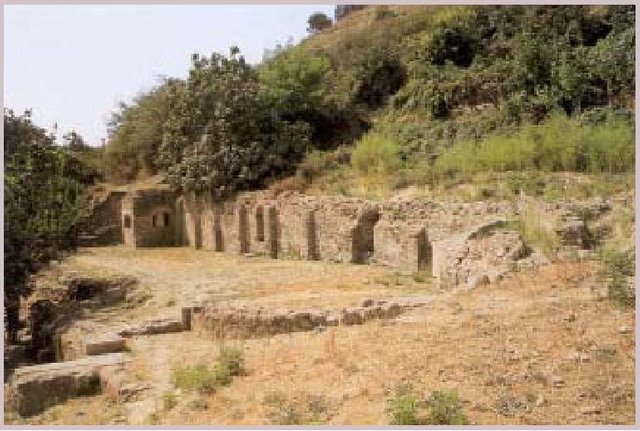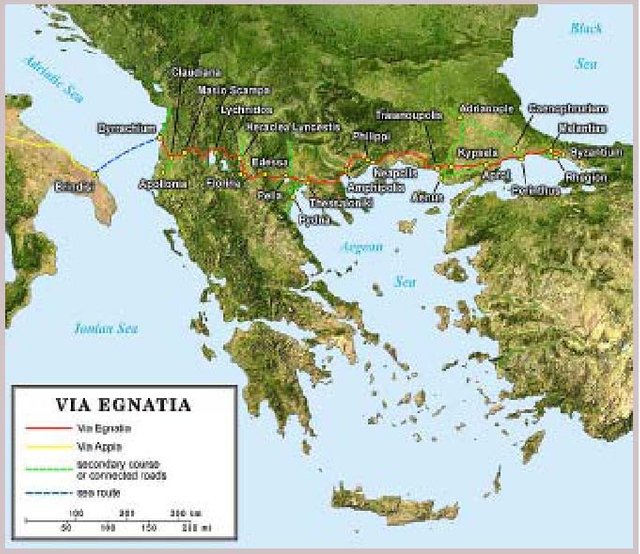HISTORY OF ALBANIA – BYZANTINE PERIOD (395-1380 A.D.)
When the Roman Empire was divided in 395 A.D, most Illyrian lands were included in the Eastern Roman Empire, later known as Byzantium. This year was a decisive turning point that determined the whole course of events to follow for the next ten centuries of Byzantine rule. The Illyrian territories presented a favorable geographical position - meaning a vital gateway from the West to the East, with the Egnatia route (Via Egnatia) as its main artery.

View of Via Egnatia route and station, 2nd century B.C.
During the 4th to 9th centuries A.D, the Illyrian territories were raided by the Visigoths, Huns, Ostrogoths and Slavs, of whom only the Slavs settled in scattered parts and in Macedonia. In the north and east, where they outnumbered the Illyrian population, the latter were Slavicized, while in the south, where the Illyrian population was more compact and the Illyrians assimilated the Slavs. In the 9th century, the native population is referred as “Arbër” and their country as “Arbëria”. At the beginning of the 18th century, these names were replaced by “Shqiptar” (Albanian) and “Shqipëri” (Albania). Both forms are used to this day.
The Arbër were distinguished from other nations by their name, language, culture and territory. Arbëria was raided by waves of invaders and for about 150 years, a large part of the country fell under the Bulgarian rule. From the end of the 11th century to the end of the 13th century, Albania turned into a battlefield between the Normans of south Italy and Byzantium. The coasts were used as a passageway for crusaders on their way to and from the Holy Land. Being situated away from Constantinople, the Arbër get little mention in Byzantine sources, though they were involved in crucial events in Constantinople, such as the revolt of George Maniakes (1043), Niqifor Brieni, Duke of Durrës (1077) and Niqifor Vasillaqi (1078).

Main Roman Empire routes maps: Via Appia and Via Egnatia
Along with the existing towns of Durrës, Ulqin, Shkodër, Lezhë, Vlorë, Orik and Butrint, new towns emerged including Berat, Gllavenicë, Prizren, Drisht, Dibër, Sarandë and Himarë. They were organized in guilds associated with Christian names of saints, such as Synergasia, Vllaznia (Frataglia) and Shkolla (Scuola). A number of towns were renowned for their products: Vlorë and Ulqin were noted for their swords, Shkodër and Ulqin for their bells, Prizren and Shkodër for their gold and silver ornaments. The Albanian farriers were distinguished for their specific way of shoeing the horses, as were the Albanian masons and carpenters for their craft.
Albanian towns were not only trade centers, but also served as hubs among Albanian regions on the one hand, and between the country and the outside world on the other. Albanian traders had established networks with many Mediterranean towns and foreign traders from Venice, Raguza, Rimini, Ancona, Kotor, Florence and Thessaloniki settled in Albania. As a result of economic and political development, some Albanian towns managed to wrest certain privileges from the central government, which served as the basis for the statutes of their towns.
The statutes served as a constitution and were recognized by the feudal chief as well. The communal legislative and executive bodies were elected and operated under these statutes. The highest body of the town was the Town’s Council. Albanian language was used in the councils of several towns.
The Arberësh nobility formed an independent principality in the midst of the Byzantine Empire. The Principality of Arbër (1190-1216) was founded by Progon, and bore the characteristics of a feudal State with a ruling dynasty, a feudal hierarchy of seniors and vassals, and legislative and executive functions.
After the death of Progon, his sons Gjin and Dhimitër succeeded him, with the principality reaching its pinnacle under Dhimitër. He was aknowledged by the same titles as other European monarchs, such as “Great Archon”, “Panhyrpersebast”, “Prince” and “Judge”. The principality extended from Pult in the north to the Devoll River in the south and from Shkodër and Durrës in the west to Dibër and Ohër in the east. It had under its possession one third of the territories inhabited by Albanians. Dhimitër established links with Raguza and Pope Innocent III, whom he asked to send a prelate to practice the Catholic religion. The Pope described him as “a nobleman and a prince of the Arbëresh”
The founding of the principality of Arbër marked the first political union of a considerable part of Albanian territories and their liberation from foreign rule. It laid the foundations for the State tradition amongst Albanians. In 1272, upon the request of some Albanian nobles, Charles I of Anjou - The King of Naples - founded the Kingdom of Arbër (Regnum Albanie). The king pledged to honor the property, privileges, autochthonous customs and traditions of the Albanian nobility, clergy and towns. During their stay in Albania, the Angevins introduced elements of Western European feudalism and Franciscan Catholic missions.
In the mid-14th century, the Albanian territories were invaded by Stephen Dushan. The Serbian invasion had a negative effect in the north, particularly in Kosovo, which was colonized by the Slavs, who adopted a policy of religious persecution. Draconian measures were taken against the Albanians who refused to convert to the Orthodox religion, like branding, cutting off of ears and noses, banishment and even death. Nonetheless, the Albanians of Kosovo defied the Serbian assimilation.
With the collapse of the Serbian Empire (1355), a number of feudal principalities were established within Albanian territories; the principality of Balshads in the North, with Shkodër as its capital; that of Topiads with Durrës as its capital; Muzakads with Berat as its capital; Zenebisht with Gjirokastër as its capital; and the Bishopric of Shpatads with Arta as its capital. The leader of the principality of Topiads held the title “Count from the Kingdom of Arbëria” and “Ruler of the whole land of Arbër”. Karl Topia claimed his origins from France, and the emblem of his principality was a lion with Angevin lilies. The principality of Balshads reached the highest stage of organization during the reign of Balsha II and a whole state apparatus was built up with employees brought from Venice. For several generations in the people’s memory, he remained a “King”. The principality stretched from Kotor and Prizren in the north to Vlorë, Himarë and Kostur in the south.
The leaders of the principalities were in bitter rivalries, so much so that Karl Topia, in his fight against the Balshads, sought the assistance of the Ottomans (the Turks), who did not leave the country for centuries to come.
Due to foreign invasions, Albanian feudalism was a mix of Byzantine and Western European institutions. Byzantine and Norman estates existed side by side. The Angevins and the Venetians in particular adopted the Western feudal organisation.